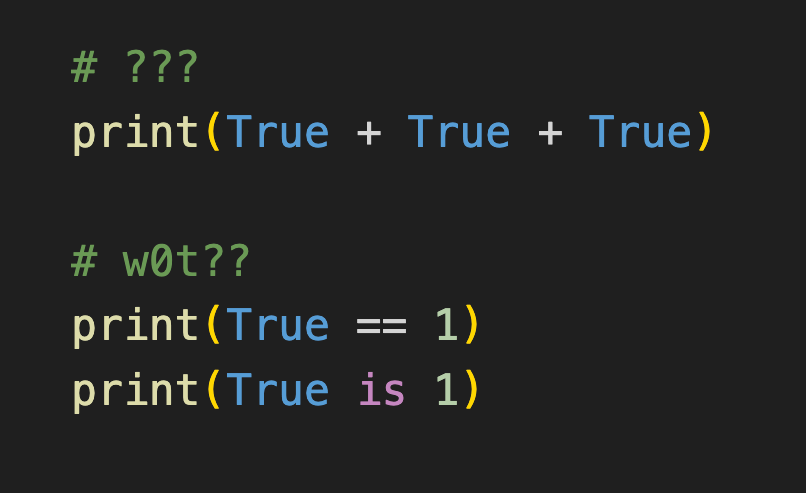Surprising Insights into Python Boolean Values: Equality, Addition, and Unexpected Behavior
Kernekoncepter
Python's boolean values exhibit some surprising and unintuitive behaviors, including equality comparisons with integers and the ability to add True values together.
Resumé
The author recently learned two interesting and unexpected things about Python boolean values:
- Comparing boolean values to integers using the equality operator (==) yields True, even though True and False are not the same as 1 and 0 when using the identity operator (is).
print(True == 1) # Trueprint(False == 0) # Trueprint(True is 1) # Falseprint(False is 0) # False
- True values can be added together like integers, which can be useful for quickly counting the number of True values in a list.
print(True + True) # 2print(True + True + True) # 3ls = [True, True, False, True, False, False, True, False]print(sum(ls)) # 4
These behaviors, while strange and unintuitive, can be useful in certain situations. The author suggests readers check out their Substack post for more cool Python boolean-related insights.
Tilpas resumé
Genskriv med AI
Generer citater
Oversæt kilde
Til et andet sprog
Generer mindmap
fra kildeindhold
Besøg kilde
zlliu.medium.com
I Recently Learn 2 Strange Things About Python Boolean Values
Statistik
True == 1
False == 0
True + True == 2
True + True + True == 3
True + True + True + True == 4
sum([True, True, False, True, False, False, True, False]) == 4
Citater
"Very strange and interesting. But it kinda does make sense I guess?"
"Unintuitive and strange behaviour, but entertaining in some way."
Vigtigste indsigter udtrukket fra
by Liu Zuo Lin kl. zlliu.medium.com 07-20-2024
https://zlliu.medium.com/i-recently-learn-2-strange-things-about-python-boolean-values-8e44f1e5735e
Dybere Forespørgsler
What are the potential pitfalls or unintended consequences of relying on the equality comparisons and addition of boolean values in Python
Relying on the equality comparisons and addition of boolean values in Python can lead to potential pitfalls and unintended consequences. One major issue is the confusion that may arise due to the dynamic nature of Python's truthy and falsy values. While True is equivalent to 1 and False is equivalent to 0 in certain contexts, this behavior can be counterintuitive and may lead to unexpected results if not understood properly. Developers might mistakenly assume that boolean values behave exactly like integers in all situations, which can result in bugs and errors in the code. Additionally, using boolean addition for counting True values in a list, although clever, can make the code less readable and harder to maintain in the long run.
How do the behaviors of Python's boolean values compare to those in other programming languages, and what are the reasons for the differences
Python's boolean values exhibit unique behaviors compared to those in other programming languages. In languages like C or Java, boolean values are strictly boolean and cannot be directly compared or added to integers. This strict typing helps prevent unintended consequences and promotes code clarity. However, Python's dynamic typing and flexibility allow for boolean values to be treated as integers in certain contexts, leading to the surprising behavior observed in the examples provided. The differences stem from Python's design philosophy of prioritizing simplicity and readability, even if it means sacrificing some strictness in type checking. While this flexibility can be convenient, it also introduces potential confusion for developers coming from languages with stricter type systems.
What other unexpected or quirky behaviors of Python's data types and language features should developers be aware of to write more robust and maintainable code
Developers should be aware of other unexpected or quirky behaviors of Python's data types and language features to write more robust and maintainable code. One such behavior is the mutable nature of certain data types like lists and dictionaries. Modifying mutable objects in place can lead to unintended side effects, especially when dealing with shared references. Another quirk is the difference between "is" and "==" comparison operators, where "is" checks for object identity while "==" checks for equality in value. Understanding when to use each comparison is crucial to avoid subtle bugs in the code. Additionally, Python's treatment of truthy and falsy values, as seen in the examples with boolean addition, requires careful consideration to ensure code clarity and predictability. By being aware of these quirks and nuances, developers can write more reliable and maintainable Python code.
0
